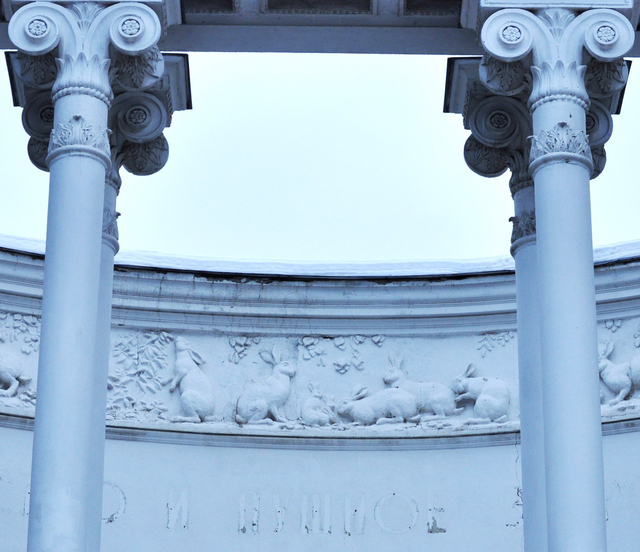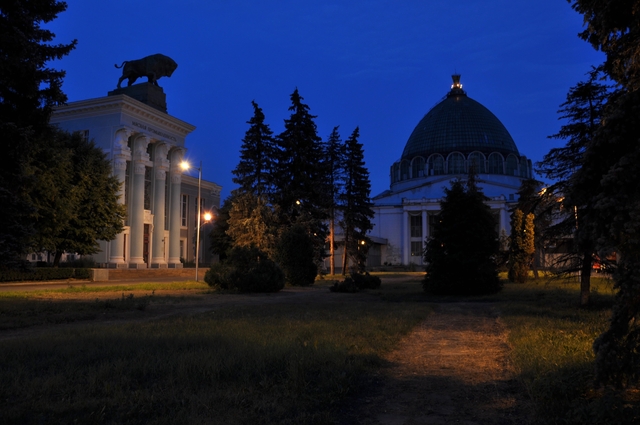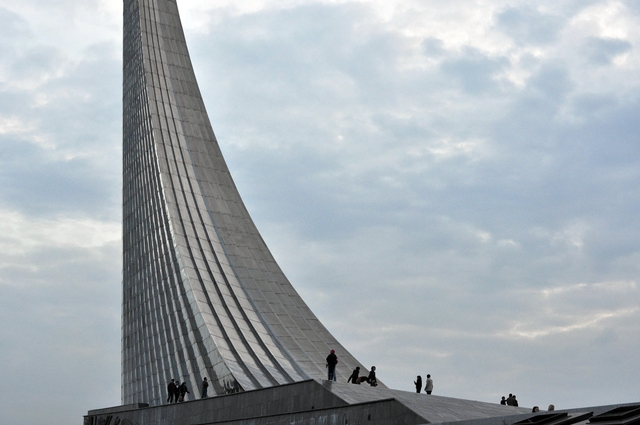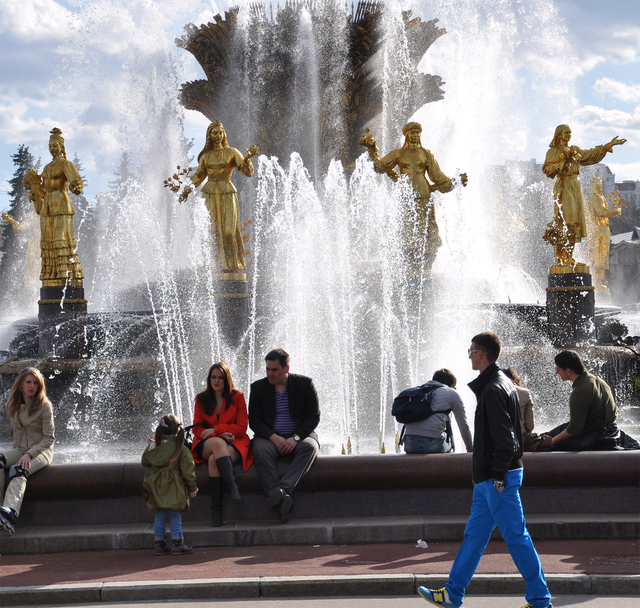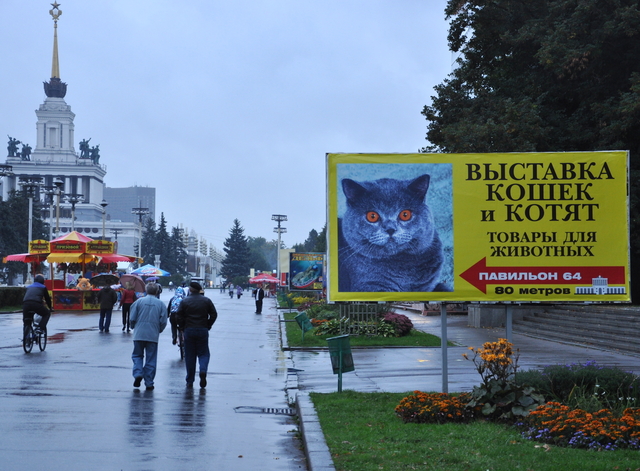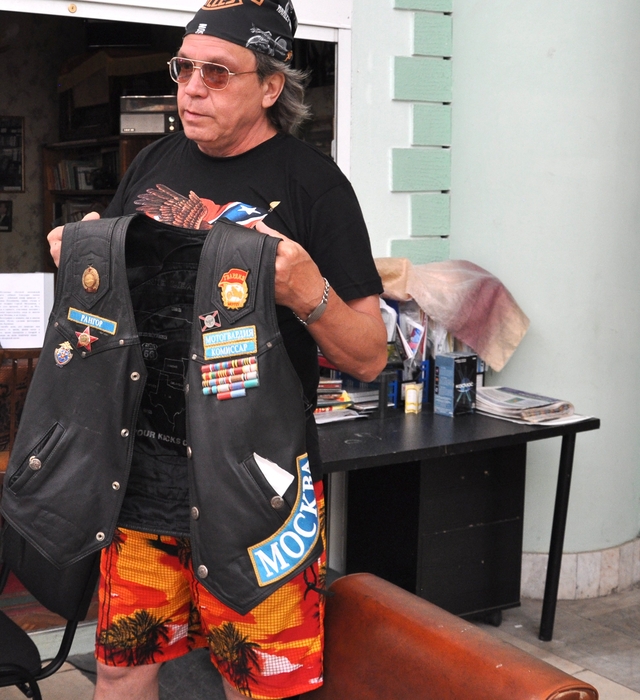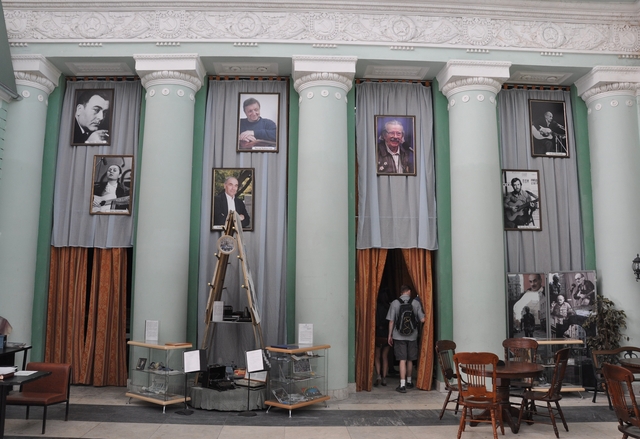The Most Soviet Park in Russia
When you think of emblematic Soviet buildings, you don’t usually think of rabbits, but there they are, dancing and frolicking, even mating across the curved frieze of the Pavilion to Rabbit-Rearing and Fur Breeding, in a far corner of Moscow’s VDNKh park. The atrium itself is fenced off by a row of impossibly skinny columns whose capitals are neither Doric, Ionic, nor Corinthian, but defiantly Soviet. The grand portico is flanked by a pair of female statues clutching a pack of their furry friends against bas-relief seashell backdrops—a cross between Botticelli’s “The Birth of Venus” and Our Lady of the Bunnies.
Like most of the park’s buildings, the pavilion celebrates innovation and achievement in a sector of the Soviet economy that all but disappeared with the fall of Communism. In the 1990s one could actually buy rabbits at the pavilion. But today the entrance plaque is barely legible, the door is locked, and the windows are opaque. Its legal status is a mystery and its façade crumbles more each year.
Neglect is just one of several outcomes for the pavilions in Russia’s most Soviet park. Others have been seized by capitalism in its most unrestrained forms: live shark shows, torture and sex museums, and a fur coat megastore with free shuttle service. And though the Ferris wheel, carnival games, kebab stands, busking rock bands, kitten saleswomen, motorcycle gangs, roller skaters, and forlorn ten-meter wheat sheath in the middle of a lake can be disorienting, one of the park’s main draws is the autonomy of wandering its 385 acres, many of which are forested and quiet.
Yet to understand modern Russia, where the Soviet legacy lingers uncomfortably on, there’s no better place to visit than VDNKh. According to Vladimir Putin, modern Russia can best be seen in the glassy athletic venues and infrastructure being built from scratch in Sochi, the host of the 2014 Olympic Winter Games. Blank slates are certainly easy for leaving marks—as Peter the Great did in the marshlands that became St. Petersburg—but they have more purchase on the future than the present. Other Soviet sites, like Lenin’s tomb, exemplify the struggle to refashion the past, but not that past’s unruly and sprawling presence, which VDNKh has in spades. Its mix of solitude and tackiness preserves a spirit of guileless accessibility, making it perhaps the only major site in modern Russia to embrace the Soviet past with pride rather than reservation. At VDNKh the Soviet era cannot simply be razed like so many redundant factories; it’s too beautiful and too beloved. It’s also massive—too indigestible to emerge sparkling and wifi-equipped on the other side of renovation, like Moscow’s Gorky Park, whose Soviet spirit has been practically erased in a seeming effort to reproduce London in Moscow. Like the Soviet past, VDNKh can be neither unified nor resolved.
After all, what can you do with a site that is both Ground Zero and Las Vegas?
Other Soviet symbols have been spared this uncertainty. The Moscow Metro and Stalin’s “Seven Sisters” towers are too functional to be interrogated for meaning; they’re simply a form of transport or the home of a government ministry. By contrast, because VDNKh is the most bricks-and-mortar monument to the Soviet past, it is also the most vulnerable. It houses its most obscure and emblematic buildings, dedicated to ideas, territories, and social groups that no longer exist, such as Friendship of the Peoples, the Uzbek SSR, and Young Naturalists and Scientists. In fact, some of the pavilions (such as Rabbit-Rearing or Peat) are almost mockingly irrelevant; their earnestness, not their agrarianness, being their most outdated and Soviet quality. Perhaps the barbarity of their destruction, the recklessness of the alterations, and the callous neglect can be explained by a sublimated revulsion against a historical mistake that was all the more tragic because it was self-induced.
There is no one narrative here; there are many individual ones. A full transformation of VDNKh would require cooperation and consensus about the Soviet legacy that don’t exist in modern Russia. Instead of one elephant in a room, it’s a cluster of about 80 massive stone, plaster and glass elephants, grazing in acres of asphalt and forest, each with their own post-Soviet afterlife.
VDNKh was the Soviet Union’s best version of itself.
Like the Moscow Metro with its marble, stained glass, and chandeliers, VDNKh is a glorious-yet-bounded space where the full promise of the Soviet dream could be realized. It is a reminder that utopias can only be built in finite spaces. Without lavish restoration and maintenance, they crumble.
In Russian, VDNKh is short for “exhibition of economic achievements,” or vystavka dostizhenii narodnykh khoziastva. This is the name that the park commonly goes by, even though in 1992 it was renamed VVTs, or “all-Russian exhibition center,” despite being born and raised from 1939 to 1959 as VSKhV, the “all-Union agricultural exhibition.” It was intended to celebrate ingenuity and effort among workers and kolkhozniki as well as to inspire them to further heights.
During the Soviet era, the promise of a yearly trip to Moscow’s VDNKh was another incentive for greater outputs. At VDNKh, the most productive sugar beet brigades from Ukraine would be invited to share their secrets. They might mingle with a pig iron team from Magnitogorsk, tobacco growers from Georgia, and sturgeon fishermen from the Caspian Sea. Or they could take a patriotic detour to learn of the achievements within the pavilions to the Arctic or Physical Culture. VDNKh reified the Soviets’ command economy into a cornucopia of fountains, columns, and promenades while affirming to Soviet laborers that in the worker-state they could be expert, hero, and king.
Here entire sectors of the economy had dedicated pavilions such as the Meat Industry, with its bull’s head columns, and Beekeeping, with its honeycomb-patterned entrance veil. And the great alliance between agriculture and industry was brought to life in the monumental sculpture Worker and Kolkhoz Woman, by Vera Mukhina, which was set just outside VDNKh’s triumphal entrance gates after returning from its 1937 debut at the Paris World’s Expo.
VDNKh also brought the entire multi-ethnic Soviet world to life, providing an ideologically unified analogue to the World’s Fairs. National republics, autonomous republics, and many Soviet regions were crystallized in architecture, ensuring that each one’s essence was legible all the way down to the door handles and stained glass—a sort of Soviet monumental Arts and Crafts. For instance, Azerbaijan’s pavilion featured a decidedly Islamic aiwan; Karelia’s almost-Athenian pediment is a wood-carved scene of lumberjacks in a forest; and the Volga Region featured a massive frieze of a hydroelectric dam. While Mechanization Square was sanctified by a towering Stalin statue (where the Vostok rocket stands today), the spatial focal point is the gold-plated fountain, Friendship of the Peoples, with its ring of female figures: each of the fifteen republics dressed in her “national” costume being doused by jets of water from a giant bundle of wheat. The fountain and the pavilion of the same name instantiated the Soviet goal to integrate the Russian empire’s distant and diverse periphery. It demonstrated that although the Soviet Union was closed from the world, VDNKh contained a world of its own.
And only in the workers’ state could pavilions be erected without irony to the most obscure corners of the economy, such as Dog-Rearing, Agroforestry, Poultry-Raising, Camels, Donkeys, Peat, Potatoes and Vegetables, Artificial Pollination, and Flax, Hemp, and Bast Fibers.
Other pavilions were downright Dionysian, like Beer, Vineyards and Wine-Making, Liqueurs, Tea and Sweets, Tobacco, Toys, and Ice Cream, which was built to look like a giant, melting scoop of vanilla with a preening seal in place of the cherry on top. There were also plenty of cafes, simple movie theaters, and an amphitheater. With apologies to Walt Disney, VDNKh in its prime must have been the Happiest Place on Earth. Its levity didn’t simply line corporate pockets nor merely brighten the faces of bourgeois children: it was proof that heaven was being built on earth.
Despite being curated entirely by the Soviet state, VDNKh’s pavilions were not immune to the bouts of destruction that beset World’s Fairs. The regime’s priorities changed and the economy evolved, which were reflected in the destruction, construction, and transformation of pavilions, making the park a palimpsest of Soviet priorities. After a wartime hiatus, VDNKh reopened grander than ever in 1954 with a Cold War focus on technology. Pavilions to Atomic Energy for Peaceful Purposes (1956), Medical Industry (1957), Geology, Gas, and Chemistry (1957), and Science (1957) emerged. As the Soviet economy grew more interwoven it became difficult to separate industrial processes and products into discrete buildings, making the pavilions more like separate-but-related themes in one Soviet industrial symphony, rather than a patchwork quilt.
The utopianism of the Khrushchev years is captured in a 1959 guidebook that praised the pavilions of Chemistry and the Chemical Industry with a tribute to polyethylene, a “miraculous material” that could replace metal and be used in hoses, films, unbreakable bottles, flasks, etc. Meanwhile, a strange figure guarding the Electrification pavilion epitomized the new era:
From a distance he seems to be a visitor from the Middle Ages, a knight clad in armor. But his armor is aluminum and underneath it he lacks a beating heart, while his veins do not flow with hot blood. His heart is mechanical and his blood is electronic. He is a robot.
The “aluminum knight” greeted visitors four times a day with a humble but hopeful greeting: “Right now I can’t do much, just turn around, walk, talk…I’m controlled by radio…We robots don’t fear work, nor heat, nor cold.” And visitors who did not speak Russian could pick up a nearby telephone receiver and listen to his message in French, English, or German.
Elektro, the humanoid robot created by Westinghouse Corporation for the 1939 New York City World’s Fair—the capitalist competitor of Khrushchev’s aluminum knight.
Yet VDNKh never forgot its agricultural core. The Corn pavilion had a six-meter cob tower in its vestibule and prompted a breathless ode to the “queen of the fields”:
She appears not only as a grain, doesn’t just transform into meat and milk. Processed corn appears in confectionary, canning, compound fats, textile, chemical, pharmaceutical, paper, construction and other industries. Looking at these exhibits we’re reminded that all sectors of the economy interact and complement one another.
Thus the metaphysics of corn demonstrated the growing complexity of the Soviet economy, its wager on high technology to produce the long-sought cornucopia, and the humble dignity of its agricultural base.
By the 1960s Khrushchev had declared the creation of a unified “Soviet people” that would soon live to see Communism. Differences in development and culture among the various Soviet republics were said to have disappeared, which meant the end of republican pavilions at VDNKh. And because Khrushchev launched a concurrent war on excessive ornamentation, the pavilions that weren’t destroyed—like Tajikistan, Turkmenistan, Kyrgyzstan—were crudely repurposed by slapping up boards, dismantling carved friezes, or shearing off decorative entrances. Among the most freakish transformations, Kazakhstan and its elegant glass atrium became Metallurgy, a large black box. Azerbaijan become the archetypal VDNKh pavilion mullet, dropping its aiwan, adding an entrance feature meant to simulate a keyboard, retaining the “Islamic” ornament in the back, and becoming Computational Technology. Armenia became the Food Processing Industry and, in 1967, Health Care, its peaked red granite frame still in place, but its concentric archways covered with white boards. Today it is home to a mini-mall of discount drug stores.
Gentler reincarnations were in store for Uzbekistan, which retained its towering columned sun-shaped pergola and became Culture. Latvia became Physics. And the former Karelia, which had been housing Russian Culture, became the Pulp, Paper, and Resin Industry. Ukraine, one of the most stunning structures, and perhaps not coincidentally the homeland of Nikita Sergeievich himself, was simply relabeled Agriculture, exonerating the horses, sheep, and beehives that still adorn its walls.
When the Soviet Union collapsed in 1991, VDNKh became a petri dish for crony capitalism, garish display, illicit activity, and neglect—in other words, Yeltsin’s Russia.
After initially being protected as a state-controlled entity, it was privatized in 1994, allowing waves of speculators to buy pavilions on the cheap and strip them of resources before reselling or turning them into warehouses for a vast weekend clothing and goods market. Successive investors jockeyed for control of the park, to charge rent and protection money, and for the rights to deploy its resources (including a branch of the Moscow police, a power station, and a customs point). The game was high-stakes, and VDNKh was the scene of several shootings between competing criminal gangs.
Although the park became “re-publicized,” the legacy of the 1990s has proved difficult to erase. The first few to seize buildings in the 1990s have squatted, paying almost nothing in rent, and engaging in mysterious activities hidden behind sign-less entrances and foggy windows. Meanwhile, the landlord of a lovingly restored but under-visited grocery store recently complained that without paying exorbitant fees to several of VVTs’s daughter companies—the ones which actually collect the protection racket—he cannot advertise his store at the entrance next to the signs for the dolphins, sharks, and cats.
Illegal buildings sprouted like mushrooms in the 1990s. And though over 100 have been demolished, a robust new love for private property has made others sacrosanct, even though most are restaurants, bars, and even a bathhouse whose clapboard and vinyl exteriors were not meant to last. The most notorious of the new is a private mansion, nicknamed the “castle of VDNKh,” built on the small lakefront between the Fishery and Rabbit-rearing pavilions by Yakub Yakubov, an Azerbaijan-born businessman best known for owning famed Moscow businesses like the Praga restaurant and the Yeliseevskii department store, as well as various casinos when gambling was still legal in the city. It has a stunning array of arches, gables, turrets, and decks, and looks like a metastasized putt-putt obstacle. While certainly a garish mix of corruption and disdain for his fellow man, it would be a great pavilion to Privatization, to be preserved in situ as perfectly capturing the spirit of the age. Yakubov also seems to have built a home in the same style in Brooklyn.
As the mistakes of the 1990s are increasingly being “corrected” in Putin’s Russia, there is renewed talk of a grand renovation. However, a plan to intersperse luxury hotels and shopping between the pavilions has foundered due to cost and lack of consensus.
Until a comprehensive renewal plan emerges, VDNKh’s pavilions offer object lessons in different post-Soviet afterlives.
The spectacular, ruined outdoor Green Theater is being absorbed back into the earth a generation after it was built.
The irreplaceable Veterinary and Hunting and Fur pavilions have been lost to fire.
Naked Capitalism has become literal: the former pavilion to the North Caucasus (i.e. modern Chechnya), and later Education, could be renamed the Pavilion of Base Instincts, where fright, sex, alcohol, pain, nostalgia, and even cuteness are for sale at its haunted house and museums of Torture, Woman’s Delight, Drunkenness, Retro USSR, and a butterfly display.
Elsewhere there are two competing live shark habitats, one of which is housed in the former pavilion to Friendship of the Peoples.
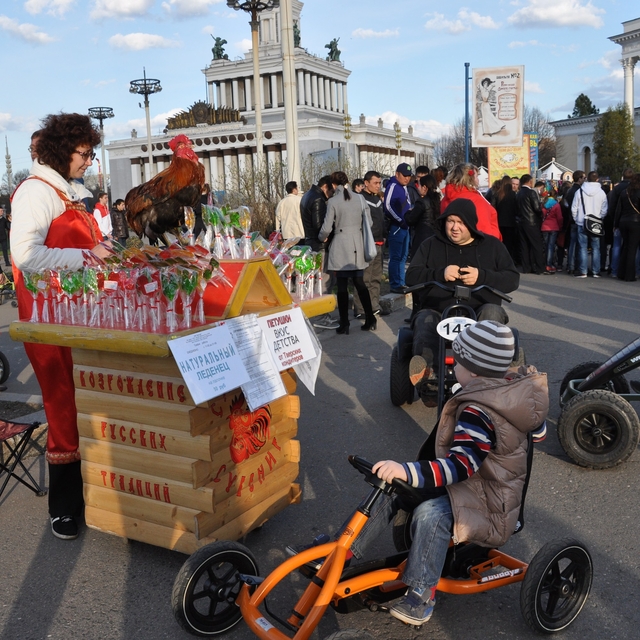
Nostalgia for sale: Rooster on a Stick candy, the “taste of childhood,” in front of the former Pavilion to the Friendship of Peoples. Charles Shaw
Russian Retail can be found in just about every corner of the park. The troika of garden seeds, beekeeping equipment, and discount herbal medicine are sometimes perfectly wed to their spaces, like the daycare center and garden seed mall in the pavilion to Young Naturalists (which also features four haunting busts to child martyrs of World War II). But they are usually found in more incongruous settings, like the Space Pavilion.
Former Soviet republics that are dependent on Russia, such as Armenia, Kyrgyzstan, and Belarus, have opted for an Updated-Chamber-of-Commerce echo of VDNKh’s original purpose. They have funded expensive restorations in order to showcase their national wares, allowing visitors to sip Armenian cognac on comfy couches and eat beshbarmak at a Kyrgyz cafe, conveniently ignoring that today’s Armenian pavilion is the former Siberia, and that Krygyzstan was actually Estonia. Meanwhile, Kazakhstan’s oil-fueled independence and Ukraine’s flirtation with the EU are likely the reason why restoration plans for these pavilions have faltered.
Finally, there are the Labors of Love, where Soviet flames are tended by those with no desire to be paid. The Circular Movie Panorama, built after Khrushchev’s angst-producing trip to America, rotates the same seven 20-minute films in perpetuity, such as “Take us with you, tourists!” and “Volga – Russian river.” (For show times, visit http://krugorama.narod.ru)
On a recent summer afternoon a group of us visited The Republic of Song, one of the grandest monuments of them all. This museum to singer-songwriters, or bards, is only the latest identity for a pavilion that has worn many names, including Building Materials, Atomic Energy for Peaceful Purposes, Light Industry, and Defense of Nature. Its soaring central vestibule encased in opaque glass is barren of religious iconography, creating a sort of bland Soviet ceremonial space suited to each of its transformations. The entrance is adorned by bulbous mosaics that simulate Soviet banners and amphorae. And extending outwards from the glassy central tower are two boxy pale-blue wings whose intricate bas reliefs have long since been lost.
We opened the door and were greeted by a tan, silver-haired man in orange board shorts, a black leather biker’s vest, and a Harley bandana who jumped down from his cot in an anteroom.
The central hall was sunlit, drawing my eyes up the glass walls to the pastel-colored carved roof, inviting a religious form of contemplation. In one corner of the room was a bar bedecked with late-Soviet motorcycle banners, in another was a campsite diorama that one could find at a Boy Scout convention, and in another was a sparse “typical Soviet kitchen,” meant to simulate the gestation site of bard songs and dissident discussions. Looking back at the man’s cluttered nook, it was clear that he lived there.
He led us generously through the central hall, adorned with portraits of Soviet bards, with the most famous—Bulat Okudzhava and Vladimir Vysotsky—hidden modestly at the far end. Like many who work (or live) in VDNKh, he was either hazy or reluctant to part with the details. He couldn’t speak to any of the building’s previous incarnations and as to its acquisition he shrugged and smiled, saying that several years ago they had merely “gotten a good price on the rent.”
We continued the tour into a darkened concert hall while our guide struggled to explain the connection among Soviet bard music, motorcycling, and opposition politics—something about freedom of expression. He ushered us into the final, darkened gallery, like an old aunt in a house full of antiques, whose homespun quality was created by the old press clippings from concerts and the giant airbrushed portrait of Vysotsky that caught the faint light.
I expected to be asked for an admission fee when we left. Instead, he gave each of us a flyer to next week’s big event: a politically-inspired biker poetry open mic.
Our host was no Communist, but he, like many of VDNKh’s gatekeepers, had found a place in the park’s dark corners to keep a Soviet votive burning amidst pharmacies, furs, and dolphins.



